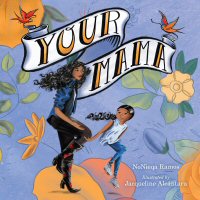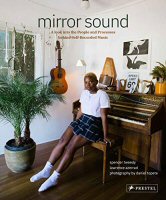Beefheart: Through the Eyes of Magic
by John French (Music 781.66 Vanvliet)
Captain Beefheart, real name Don
Van Vliet, was one of the most fascinating figures to emerge from the rock and
roll scene of the 1960s. The good Captain started with some relatively
conventional music rooted in the blues, but quickly found his way to composing
some of the most unorthodox music of the 60s. In particular, he is remembered
for his 1969 album “Trout Mask Replica,” a downright inscrutable record that
almost sounds like sloppy improvisation on the first listen, but in fact is
totally composed and carefully rehearsed. It wasn’t a popular record upon
release, but has come to be included on almost every “greatest album of the
60s” kind of list by major music publications in subsequent decades.
Beefheart was a unique person, to
put it diplomatically, and legends abound around his personality, the way he
ran his bands, and even the basic facts of his biography. Beefheart himself
often added to the confusion and mystery around these subjects in interviews,
making it difficult to figure out what really happened around the creation of
some of his most iconic work. But drummer John French, who worked with
Beefheart on his debut LP and 7 more of his most notable records, wrote an
extensive biography of Beefheart that was published in 2010. In 2021, Beefheart: Through the Eyes of Magic was revised
and published again, and you can now borrow it from the Polley Music Library.
The book has been returned to print
by a British record label, The Last Music company, and I don’t think this book
has gone through the kind of rigorous editing process that a conventional
publisher would demand. The fonts are tiny and run dangerously close to the
margins. The sheer size of the book is daunting: it could and probably should
have been tightened up by an assertive editor. And there is no index.
Editing and formatting issues aside,
the information here is simply unbeatable. Not only is French himself the
perfect person to frame a discussion of Beefheart’s working processes, as he
held tenure as the “musical director” responsible for transcribing and
arranging his bandleader’s cryptic piano tapes and whistling for the full band,
but he did his due diligence for this book, interviewing tons of former Magic
Band musicians and associates of Beefheart. The result is as clear a picture of
Beefheart and the scene immediately surrounding him as we’re ever going to get.
And this makes for some fascinating reading:
many of the Beefheart myths are soundly struck down, others are substantiated,
and there are, for better or worse, many situations where the real story is
even more bizarre than the myths could contain.
And in many cases, if you’re
inclined to like Beefheart, “for better or worse” lands on the side of worse.
At a personal level, it’s hard to make it through this book and still think of
him as a likeable fellow. But on a musical level, you start to see the many
complexities involved with the Magic Bands over the years, and how much the
many talented musicians who worked with Beefheart contributed to the music.
It’s an interesting position to be in after reading
through a rock and roll bio: My respect and admiration for the music remains
intact — indeed, in some cases, it has grown — while my admiration for the
person whose name graces the album covers is diminished. To quickly summarize
his behavior without giving away too many spoilers in the book, I think it’s
fair to say that at the height of his creative powers, Beefheart became an
increasingly cruel and abusive person to his band members and those closest to
him. At times, his behavior starts to parallel that of a cult leader or a
dictator, his interactions alternately like a “tough-love” paternal figure or
simply adversarial.
But there are other narratives that
you can latch onto as you navigate through this book. Although Chapter 1 starts
with a fairly harrowing story of Beefheart’s abuse during the “Trout Mask”
period, French then turns it into a brief introduction, where he divides the
Magic Band into three broad eras. His interviews will go on to focus on the
earliest two eras, though some members of the final lineups are interviewed as
well. French also returned to the band for Beefheart’s penultimate album, “Doc
at the Radar Station.” After a couple of pages of this introductory material,
the book switches to a mostly chronological tale. And it’s from this chronology
that you can follow the observations and careers of other Magic Band members.
In general, most of the Magic Band members over time ran considerably younger
than Beefheart — for many of them, the Magic Band served as their first
experience as professional musicians around the age of 17 or 18, while
Beefheart himself was around 26 when his debut full length “Safe As Milk” was
released. In the middle era of the band, French generally observes that this
age difference naturally gave Beefheart a bit of an advantage over his younger
bandmates, whose expectations about being in a band were generally naïve, and
as the music became more idiosyncratic, they were pulled along even though they
mostly joined thinking of it as a rhythm and blues project. In contrast, the
later iterations of the band were filled by musicians who were already fans of
Beefheart’s late 60s and early 70s music, and had more of an understanding of
what they were getting into.
What were they getting into? If we
go back to the mid-period Magic Band, which French delineates around the “Trout
Mask” and “Decals” albums, we get to the biggest mythical period of the
Beefheart story, which largely surrounds the production of the “Trout Mask
Replica” album. It turns out that many of the stories told over the years were
true: the Captain more or less held his band hostage in a rented house where
they lived for 8 months. After being used to playing shows and making some
money, they were suddenly thrown into a surreal situation where Beefheart
conveyed his musical ideas primarily through French, who had to transcribe and
arrange them to somehow work with typical rock band orchestration, and the band
were expected to practice for 14 hours a day. The financial situation at the
house became dire, with Beefheart feeding the band a cup of soybeans each day
per member for about a month. Several members had to resort to stealing food
from the nearest grocery store, were caught, and had to be bailed out by
Beefheart’s childhood friend and record producer Frank Zappa. And Beefheart
played mind games with the band in an attempt to maintain their focus on him
and prevent a mutiny. It sounds like a harrowing experience, and French retells
it through a combination of his own recollections and conversations with a few
members of the band at the time.
French left and returned to the
band several times, and information on the periods where he wasn’t in the band
is naturally less detailed. The bulk of the book focuses on the early days of
the band through “Trout Mask.” There is a shorter section devoted to French’s
return for the “Decals” record and subsequent touring, and a very interesting
account of the “Bat Chain Puller” era, intriguing because the album was
ultimately shelved due to a disagreement between producer Zappa and his manager
Herb Cohen. And French returned again at the dawn of the 1980s to work on “Doc
at the Radar Station,” which gets some discussion. The activity around other
albums is mentioned through interview snippets with band members, with the
exception of the mid-70s period around the “Unconditionally Guaranteed” and
“Bluejeans and Moonbeams” albums, a period most fans and critics agree was a
failed attempt to make Beefheart into a more commercial radio-friendly
enterprise.
Although the book is mostly focused
on Beefheart and his bands, there are sections that are more autobiographical
about French. These show up with more frequency toward the end of the book, as
he starts to become more confident in his own adult identity separate from
being part of the Magic Band, and as he finds himself drawn to organized
religion. I found these sections interesting both as personal anecdotes and as
a kind of longer-term response to the abuse he and other band members suffered
under Beefheart in the previous decades. This really is a complex story of
personalities in the end, where those who were the target of Beefheart’s bad
behavior mostly came to forgive him over the years. But it’s difficult reading at times, too, especially in light of
the way Beefheart was represented in the music press during his career. For a
figure often discussed mostly as a childlike genius/savant type, one certainly
has to reevaluate the Beefheart legacy after this book.
(If you enjoy this, you may also
wish to try Captain Beefheart: The Biography by Mike Barnes, Songs in the Key of Z : The Curious Universe of Outsider Music
by Irwin Chusid or Frank: The True Story That Inspired the Movie by Jon
Ronson.)
( Wikipedia page for Captain
Beefheart | ( Wikipedia page for musician/author John
French )
Recommended
by Scott S.
Polley Music Library
Have you read or listened to
this one? What did you think? Did you find this review helpful?
New reviews appear every month on the Staff Recommendations page of the BookGuide website. You can visit that page to see them all, or watch them appear here in the BookGuide Blog individually over the course of the entire month. Click the tag for the reviewer's name to see more of this reviewer’s recommendations!
Check out this, and all the other great music resources, at the
Polley Music Library, located on the 2nd floor of the Bennett Martin Public Library at 14th & "N" St. in downtown Lincoln. You'll find biographies of musicians, books about music history, instructional books, sheet music, CDs, music-related magazines, and much more. Also check out
Polley Music Library Picks, the Polley Music Library's e-mail newsletter, and
follow them on Facebook!






























